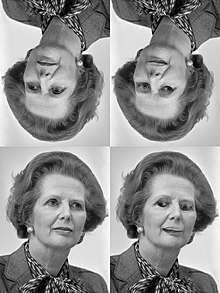Thatcher effect
The Thatcher effect or Thatcher illusion or Eyesmouth-Wrongway is a phenomenon where it becomes more difficult to detect local feature changes in an upside-down face, despite identical changes being obvious in an upright face. It is named after the late British prime minister Margaret Thatcher, on whose photograph the effect was first demonstrated. The effect was originally created in 1980 by Peter Thompson, Professor of Psychology at the University of York.[1]

Overview
The effect is illustrated by two originally identical photos,[2] which are inverted. The second picture is altered so that the eyes and mouth are vertically flipped, though the changes are not immediately obvious until the image is viewed in normal orientation.
This is thought to be due to specific psychological cognitive modules involved in face perception which are tuned especially to upright faces. Faces seem unique despite the fact that they are very similar. It has been hypothesised that we develop specific processes to differentiate between faces that rely as much on the configuration (the structural relationship between individual features on the face) as the details of individual face features, such as the eyes, nose and mouth.
There is evidence that rhesus monkeys[3][4] as well as chimpanzees[5] experience the Thatcher effect, raising the possibility that some brain mechanisms involved in processing faces may have evolved in a common ancestor more than 30 million years ago.
The basic principles of the Thatcher effect in face perception have also been applied to biological motion. The local inversion of individual dots is hard, and in some cases, nearly impossible to recognize when the entire figure is inverted.[6]
Further investigations
The Thatcher illusion has also been useful in revealing the psychology of face recognition. Typically, experiments using the Thatcher illusion look at the time required to see the inconsistent features either upright or inverted.[7] Such measures have been used to determine the nature of the processing of holistic facial images.[8]
By looking at the intermediate angles between upright and inverted, studies have explored the gradual or sudden appearance of the illusions.[9][10] The observation of the Thatcher illusion has been found in all groups that it has been tested in. Children observe the illusion,[11] as do children with autism[12] and even people with prosopagnosia.[13]
See also
References
- Thompson, P. (1980). "Margaret Thatcher: a new illusion" (PDF). Perception. 9 (4): 483–484. doi:10.1068/p090483. PMID 6999452.
- "Reading Upside-down Lips". faculty.ucr.edu. Retrieved 11 April 2013.
- Adachi Ikuma, Chou Dina P., Hampton Robert R. 'Thatcher Effect in Monkeys Demonstrates Conservation of Face Perception across Primates', Current Biology 2009, 19, 1270–1273
- Dahl Christoph D, Logothetis Nikos K, Bülthoff Heinrich H, Wallraven Christian 'The Thatcher illusion in humans and monkeys', Proceedings of the Royal Society B: Biological Sciences, 2010, 277 (1696)
- Weldon, K. B., Taubert, J., Smith, C. L., & Parr, L. A. (2013). 'How the Thatcher illusion reveals evolutionary differences in the face processing of primates'. Animal cognition, 16(5), 691-700.
- Mirenzi A, Hiris E, 2011, "The Thatcher effect in biological motion" Perception 40(10) 1257 – 1260
- Sjoberg, W., & Windes, J. D. (1992)
- Lewis, M.B. & Johnston, R.A. (1997). The Thatcher Illusion as a test of configural disruption. Perception, 26, 225-227.
- Stuerzel, F., & Spillmann, L. (2000). Thatcher illusion: dependence on angle of rotation. Perception, 29(8), 937-942.
- Lewis, M. B. (2001). The lady's not for turning: Rotation of the Thatcher illusion. Perception, 30(6), 769-774.
- Lewis, M.B. (2003). Thatcher’s children: Development and the Thatcher illusion. Perception, 32, 1415-1421.
- Rouse, H., Donnelly, N., Hadwin, J. A., & Brown, T. (2004). Do children with autism perceive second-order relational features? The case of the Thatcher illusion. Journal of Child Psychology and Psychiatry|J Child Psychol Psychiatry, 45(7), 1246-1257.
- Carbon, C. C., Grüter, T., Weber, J. E., & Lueschow, A. (2007). Faces as objects of non-expertise: Processing of Thatcherised faces in congenital prosopagnosia. Perception, 36(11), 1635-1645.
External links
| Wikimedia Commons has media related to Thatcher effect. |